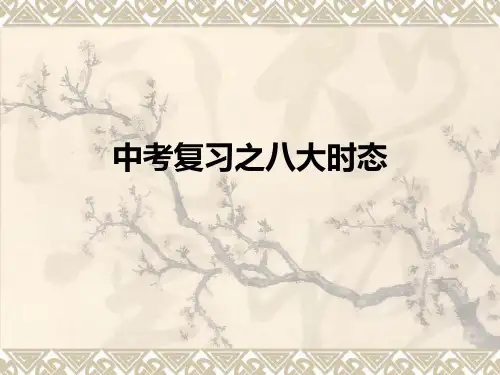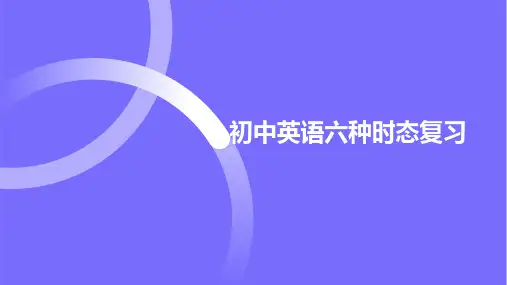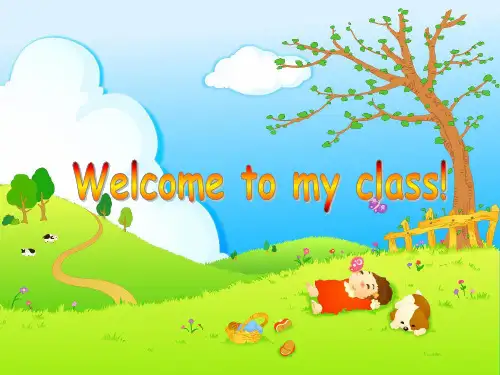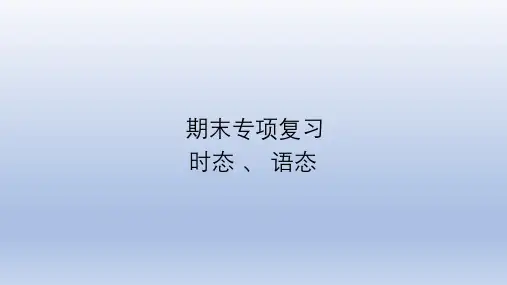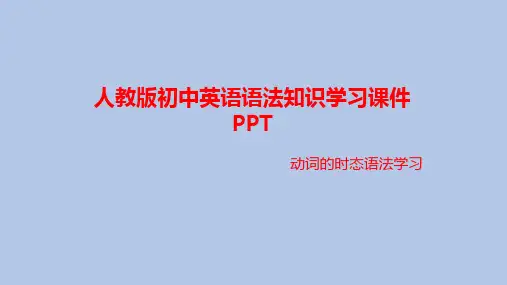- 1、下载文档前请自行甄别文档内容的完整性,平台不提供额外的编辑、内容补充、找答案等附加服务。
- 2、"仅部分预览"的文档,不可在线预览部分如存在完整性等问题,可反馈申请退款(可完整预览的文档不适用该条件!)。
- 3、如文档侵犯您的权益,请联系客服反馈,我们会尽快为您处理(人工客服工作时间:9:00-18:30)。
2. He plaies football very well. plays 3. Does Tom has a good friend? have
4.---When does your brother come
back?
did
---About half an hour ago.
5.—Excuse me. You shouldn’t smoke here. Look at the sign “NO SMOKING HERE.”
B. don't do
C. didn’t do
D. won’t do
D. begins
9. Neither I nor he _____.
A. can swims well B. are swimming well C. swims well D. have swum well
l0. Betty ____ morning exercises yesterday.
A. not did
地球绕太阳转动。 4)在复合句中,当主句是一般将来时,时间状语 从句或条件状语从句的谓语动词只能用一般现在 时来表示将来。
例如: I'll tell him the news when he comes back. 他 回来时,我将告诉他这个消息。
If you take the job , they will talk with you in greater details.
1) 表示经常性的或习惯性的动作或状态,常与 表示频率的副词连用。常用的频率副词有: always、 usually、 often、sometimes, seldom(很 少).频率副词在句中通常位于行为动词之前, 系动词、助动词之后,常与其连用的时间状语 有:every
morning(day, week, month, year…)once a week, on Sunday…。
2.过去进行时的用法:
1)表示在过去某时刻正在进行或发生的动作,通常与 表示过去的时间状语连用(如:at that time,at+过去 的具体时间,或以when 引导的一般过式的从句, 主句常用过去进行时)。
例如:At this moment yesterday, I was packing for camp.
• 5. _____ they ____ (have) a meeting at 4 yesterday Байду номын сангаасfternoon? No, they _____. They _____ (clean) the classroom.
现在进行时,
进 am,is,are,-ing。
行 时
过去进行时, was,were,-ing。
A. didn’t write
B. hadn’t written
C. hasn’t written
D. won’t write
8. At the age of eleven, my grandfather _____ to work in a factory.
A. began
B. has begun C. will begin
她告诉我她将去海南度假。
• 1. I _____ (have) my breakfast at half past six yesterday morning.
• 2. Mary _____ (go) over her lessons from six to seven last night. John and peter ____(do) the same thing.
例如:You are always changing your mind.
你老是改变主意。
2)表示渐变,这样的动词有:get, grow, become, turn, run, go, begin等。
例如 The leaves are turning red. 叶子在变红。
It's getting warmer and warmer.
常见标志词:now,look,listen,at this moment, at present,at thistime…
例如:We are waiting for you now. 我们正在等你。
现在进行是的特殊用法
1)表示反复发生的动作或持续存在的状态,常与 always, forever 等词连用,往往带有说话人的 主观色彩。
• 3. What _____ you ___ (do) at that time? We _____ (watch) TV.
• 4. Was your father at home yesterday evening? Yes ,he was. He _____ (listen) to the radio.
天越来越热了。
动词原形变为动词现在分词的规则:
六、过去进行时
1.过去进行时的结构: 主语+was/were+动词现在分词+其它 I was doing my homework at that time. (doing就是do的现在分词) They were doing their homework at that time.
例如: He often goes swimming in summer.
他夏天经常游泳。
I usually leave home for school at 7 every morning.
3)表示客观真理,客观存在,自然现象。
例如:The earth moves around the sun.
如果你接受这份工作,他们将和你谈谈细节。
二、一般过去时 一般过去时表示过去发生事,谓语要用过 去式,一般直接加ed若是特殊得硬记。
常见标志词:yesterday, the day before yesterday, last week (last+时间) an hour ago(时间+ago), just now, in 1982(in+过去具 体时间),after three days (after+一段时间)
---Sorry, I don’t see it. didn’t
动词的时态结构歌谣
一 一般现在时,动词用原型; 般 单数三人称,动词加“s” 。 时 一般过去时,动词加“ed”。
I work. He works. I worked.
三、现在进行时
1.现在进行时表示正在发生事,结构be+动词 ing,be由主语来决定。
Jim does his homework every day. (does就是do的第三人称单数形式)
动词原形变为第三人称单数形式的规则:
规则 一般在词尾加-s
动词原形
play leave swim
第三人称单数形式
plays leaves swims
以字母s,x,ch,sh,o结尾 的词加-es
A. were B. am
C. is
D. are
.2. I’ll talk to him when he ______.
A. come B. will come
C. comes
D. came
3.Father ____ his cap and went out.
A. put on
B. puts on
C. had put
A. was having B. would have
C. is having
D. had
.6.Both of the two dictionaries ____ very useful.
A. are
B. is
C. was
D. am
7. He _____ to me since last month.
初中英语动词时态复习
一、一般现在时 二、一般过去时
三、一般将来一时般现在四时、过去将来时 五、现在进行一时般现在六时、过去进行时 七、现在完成时 八、过去完成时
一、一般现在时 1.一般现在时的结构:
主语+动词原形+其它 I do my homework every day. 主语+am/is/are+其它 I am a student. 注意:当主语是第三人称单数时,动词要用第三人 称单数形式。
D. will put on
4._____ she _____ TV at seven yesterday evening ?
A. Was…watching B. Is…watch C. Has… watched D. Will…watch
.5.He can’t go to the cinema with me because he ____ a meeting.
例句:I am working.
例句:I was working.
小结(Summary):
做动词时态题的时候要注意以下几个方面:
1.根据时间状语确定时态 2.根据上下文已有时态信息点确定时态 3.上下文语意确定时态 4.在复合句根据时态呼应确定时态 5.时态中的“特殊”对策
1. Neither of us ______ a doctor.
例如:Where did you go just now?
刚才你上哪儿去了?
After a few years, she started to play the piano.
几年后,她开始弹钢琴。
A Quick-answering Game 请找出句子中的错误,并改正。
1.We are go to school on foot. 去掉
以辅音字母加y结尾的 词,先变y为i, 再加 -es
